AMD Ryzen 9 5980HS Cezanne Review: Ryzen 5000 Mobile Tested
by Dr. Ian Cutress on January 26, 2021 9:00 AM EST- Posted in
- CPUs
- AMD
- Vega
- Ryzen
- Zen 3
- Renoir
- Notebook
- Ryzen 9 5980HS
- Ryzen 5000 Mobile
- Cezanne
CPU Tests: Encoding
One of the interesting elements on modern processors is encoding performance. This covers two main areas: encryption/decryption for secure data transfer, and video transcoding from one video format to another.
In the encrypt/decrypt scenario, how data is transferred and by what mechanism is pertinent to on-the-fly encryption of sensitive data - a process by which more modern devices are leaning to for software security.
Video transcoding as a tool to adjust the quality, file size and resolution of a video file has boomed in recent years, such as providing the optimum video for devices before consumption, or for game streamers who are wanting to upload the output from their video camera in real-time. As we move into live 3D video, this task will only get more strenuous, and it turns out that the performance of certain algorithms is a function of the input/output of the content.
HandBrake 1.32: Link
Video transcoding (both encode and decode) is a hot topic in performance metrics as more and more content is being created. First consideration is the standard in which the video is encoded, which can be lossless or lossy, trade performance for file-size, trade quality for file-size, or all of the above can increase encoding rates to help accelerate decoding rates. Alongside Google's favorite codecs, VP9 and AV1, there are others that are prominent: H264, the older codec, is practically everywhere and is designed to be optimized for 1080p video, and HEVC (or H.265) that is aimed to provide the same quality as H264 but at a lower file-size (or better quality for the same size). HEVC is important as 4K is streamed over the air, meaning less bits need to be transferred for the same quality content. There are other codecs coming to market designed for specific use cases all the time.
Handbrake is a favored tool for transcoding, with the later versions using copious amounts of newer APIs to take advantage of co-processors, like GPUs. It is available on Windows via an interface or can be accessed through the command-line, with the latter making our testing easier, with a redirection operator for the console output.
We take the compiled version of this 16-minute YouTube video about Russian CPUs at 1080p30 h264 and convert into three different files: (1) 480p30 ‘Discord’, (2) 720p30 ‘YouTube’, and (3) 4K60 HEVC.
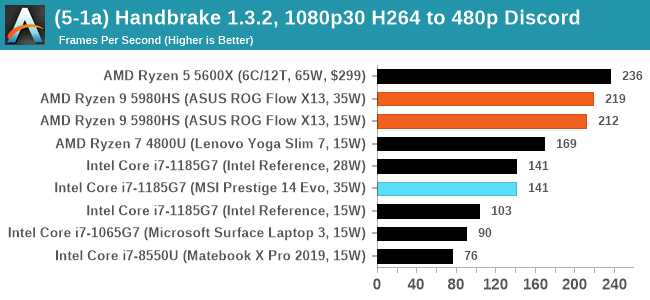
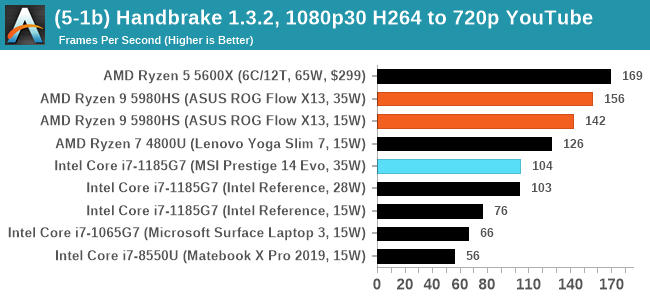
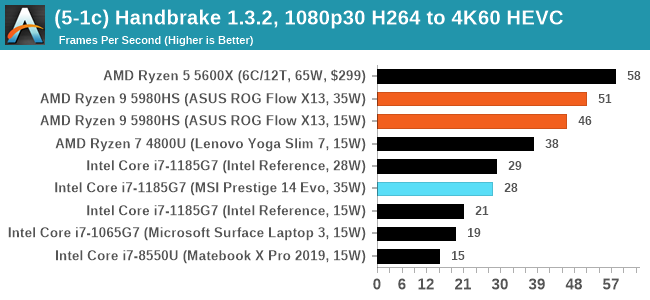
Threads wins, although the +30W difference to the desktop processor with two fewer cores can't be overhauled. Almost though.
7-Zip 1900: Link
The first compression benchmark tool we use is the open-source 7-zip, which typically offers good scaling across multiple cores. 7-zip is the compression tool most cited by readers as one they would rather see benchmarks on, and the program includes a built-in benchmark tool for both compression and decompression.
The tool can either be run from inside the software or through the command line. We take the latter route as it is easier to automate, obtain results, and put through our process. The command line flags available offer an option for repeated runs, and the output provides the average automatically through the console. We direct this output into a text file and regex the required values for compression, decompression, and a combined score.
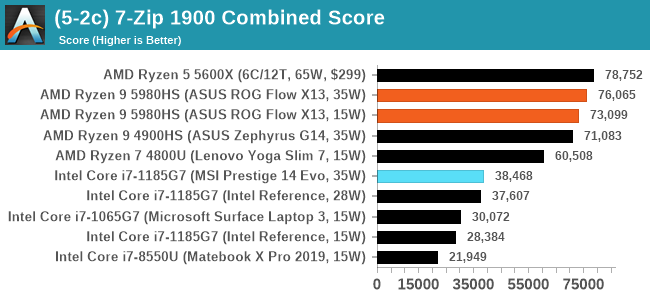
AES Encoding
Algorithms using AES coding have spread far and wide as a ubiquitous tool for encryption. Again, this is another CPU limited test, and modern CPUs have special AES pathways to accelerate their performance. We often see scaling in both frequency and cores with this benchmark. We use the latest version of TrueCrypt and run its benchmark mode over 1GB of in-DRAM data. Results shown are the GB/s average of encryption and decryption.
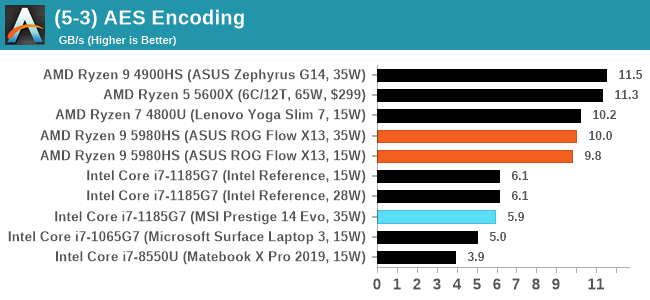
For our AES test here we actually had a small regression in performance. This could mean that there is additional performance hits to accessing the AES unit this time around, or the lower latency DDR4 of the Zephyrus is beating out the LPDDR4 on our Flow X13.
WinRAR 5.90: Link
For the 2020 test suite, we move to the latest version of WinRAR in our compression test. WinRAR in some quarters is more user friendly that 7-Zip, hence its inclusion. Rather than use a benchmark mode as we did with 7-Zip, here we take a set of files representative of a generic stack
- 33 video files , each 30 seconds, in 1.37 GB,
- 2834 smaller website files in 370 folders in 150 MB,
- 100 Beat Saber music tracks and input files, for 451 MB
This is a mixture of compressible and incompressible formats. The results shown are the time taken to encode the file. Due to DRAM caching, we run the test for 20 minutes times and take the average of the last five runs when the benchmark is in a steady state.
For automation, we use AHK’s internal timing tools from initiating the workload until the window closes signifying the end. This means the results are contained within AHK, with an average of the last 5 results being easy enough to calculate.

Another small performance uplift for WinRAR.


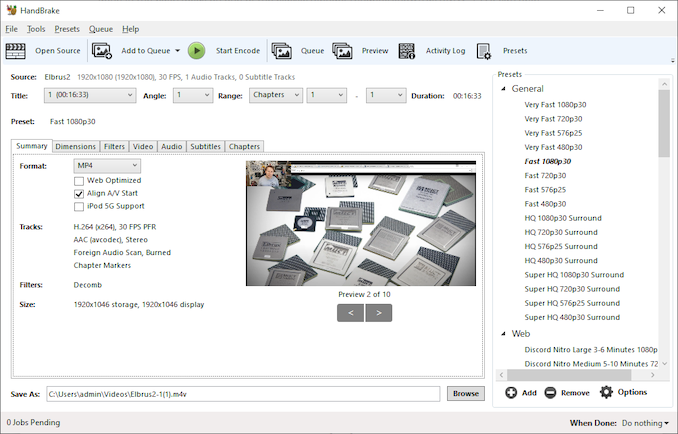
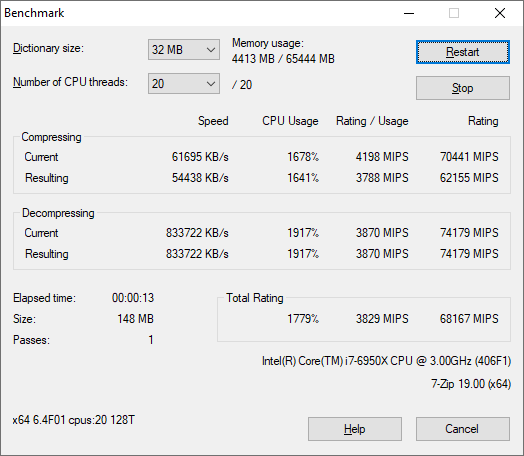









218 Comments
View All Comments
Lemnisc8 - Tuesday, January 26, 2021 - link
Can someone PLEASE find out if this thing is running in quad channel or dual channel lpddr4x. It’s already at a disadvantage since lpddr4x has half the bus width of standard ddr4. It would be fine if it ran in quad channel because it’s bus width would then be the same size as ddr4 at 128 bits, but no reviews anywhere show what channel configuration it’s running in...neblogai - Tuesday, January 26, 2021 - link
I don't think there were any 4000-series laptops running LPDDR4x just dual channel- I've only seen it to be quad-channel. So this flagship device (and used by AMD to impress about 5000H performance) should be no different.xza23 - Tuesday, January 26, 2021 - link
As always , excellent article , thank you!watzupken - Tuesday, January 26, 2021 - link
I feel with the introduction of Renoir, what blew most away is the fact that AMD managed to squeeze 8 cores into the U series. Not only that, the Zen 2 architecture also resulted a some serious uplift in performance as compared to the previous Zen+. This year round while it is all nice and good to see decent performance bump, the wow factor is not there. I am not expecting a core increase especially on the same N7 node, and to be honest, 8 cores is plenty of performance for a mobile PC.On the point of still using Vega, despite the age, Vega is still very competitive. One may argue that Intel's Xe graphics is better, but reviews out there proved otherwise. Xe is certainly fast, but both the iGPUs from AMD and Intel are likely memory bandwidith limited if one is pushing 1080p. Adding more cores will likely have diminishing returns. And honestly if you are a gamer, you cannot avoid getting a system with a dedicated GPU no matter how good the iGPU is.
Fulljack - Wednesday, January 27, 2021 - link
I agree, the R&D cost of moving from Vega to RDNA probably isn't worth it in the grand scheme of business.rumor has it that in 2022, Rembrandt will still leverage Zen 3 CPU but will use RDNA2 with DDR5 memory.
Ptosio - Wednesday, January 27, 2021 - link
Shouldn't it be pretty straightforward given that these APU already kind-of exist in the consoles?Hopefully Alder Lake would push AMD to offer best CPU/GPU combination they have!
As I understand, going to RDNA2 would also mean smaller core for the same performance? So there should be some savings in it for AMD as well.
Spunjji - Thursday, January 28, 2021 - link
"Shouldn't it be pretty straightforward given that these APU already kind-of exist in the consoles?"Those APUs use a totally different memory subsystem, much larger GPU slices, and they also use Zen 2 cores. AMD were specifically aiming to get Zen 3 out across their range - there's probably a lot of work needed to scale RDNA 2 down to iGPU levels without unbalancing its performance.
zamroni - Tuesday, January 26, 2021 - link
Amd should reduce Cezanne's core count to 6 then use the transistor budget for more gpu cores.That way it will beat all Intel laptop processors at all aspects
dicobalt - Tuesday, January 26, 2021 - link
Now they need to sell a version that cuts out the silly integrated graphics and uses a faster dedicated GPU. I don't understand the motivation for having a steroid pumped 8 core CPU paired with anemic integrated graphics. It seems AMD is more interested in selling the idea of APUs than actually providing a balanced system.Zizy - Wednesday, January 27, 2021 - link
AMD is clear that integrated GPU is for the very same chip at 15W. It is a pretty fine GPU there, TDP and bandwidth limit potential anyway. I wonder what is the die area saving by ditching GPU. If it is sizeable then yeah, it would be great to have a GPU-less variant of the chip, especially with current wafer supply issues.